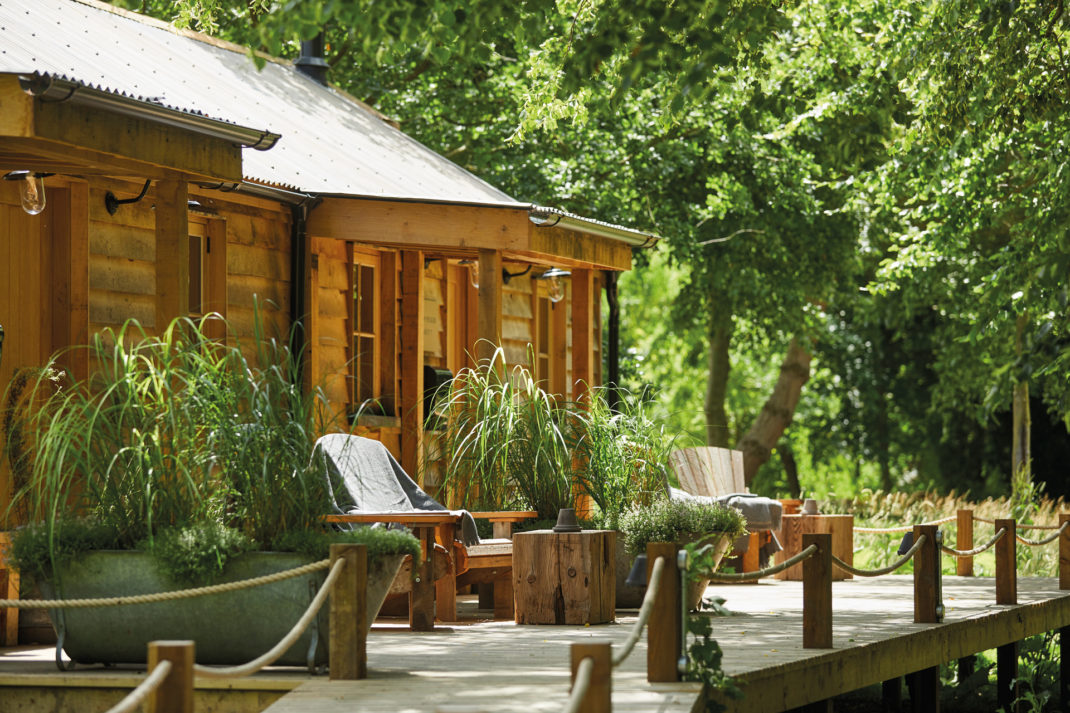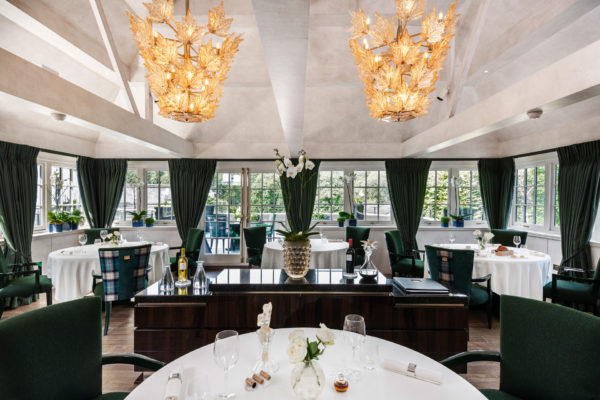
From Cabin To Castle: The Best Scottish Countryside Stays
By
10 months ago
Cabin-to-Castle living
A cabin-to-castle countryside Scottish sojourn makes the perfect nature-culture staycation, says Lucy Cleland.
How To Do A Scottish Countryside Staycation Right
There was really no choice other than to jump in. A quick look left and right through the dense foliage, and a listen for the sounds of human noise confirmed not another soul was near. So we stripped off and picked our way over the root-encrusted bank into the cool loch. There was something so utterly seductive about stumbling upon this watering hole when we were hot and sticky from walking, the delicious shock of the cold on warmed-up skin.
This was just one of the delights of staying at the equally seductive new Leckie Treehouses (from £245 a night; leckietreehouses.co.uk) near Stirling in central Scotland, just around an hour’s drive northeast of Edinburgh. A world away from city distractions, the only sounds were the wind, the crickets and the birds (this was great bird-watching terrain).
It’s not often that you can say a treehouse out-styles your own home, but this Scandi-style beauty (one of just four), perched on four metre stilts, between huge oak and beech trees, did just that. Its clean lines, floor-to-ceiling windows, exposed wood walls, tree-top terrace, log burner and outdoor copper tub, were truly gorgeous. Everywhere you looked, an unimpeachable vista of woodland, cow-flecked pasture or tree-lined hillside was given to you as a gift. Even the fact that it had no wifi – in their bid for its guests to ‘switch off’ – did not freak my digitally native children out too much, the sweetest words to a mother’s ears being, ‘Let’s go and explore’, instead.
And explore we did. There were plenty of walks recommended in the book (skinny-dipping optional), including to the local pub, the Gargunnock Inn, for decent grub if you didn’t fancy cooking at home (although the Smiddy Farm shop just down the road offered excellent home-made curries, pies and more – at ‘farm shop’ prices). It was also just a short drive to Stirling Castle, Scotland’s most strategically important, which dominates the town from its hilltop vantage. It was here that Mary, Queen of Scots, was crowned at just six days old when her father, James V, nephew of King Henry VIII, died aged just 30 of cholera or dysentry. The rest, as they say, is history. I put in a bid to visit the William Wallace monument nearby (I’m a descendant, so family folklore goes, of Scotland’s most famous warrior – and Mel Gibson’s most memorable film role).

Glen Glack
Further north, our next stop was another back-to-nature stay at Glen Glack, a collection of five larch-clad log cabins (from £270 a night; atholl-estates.co.uk), built on raised legs to leave as little impact as possible, on the side of the Cally loch. They are a new accommodation offering from the vast Atholl Estate, which covers some 120,000 acres of Highland Perthshire and stretches from Dunkeld in the south to the wild mountains of the Cairngorms in the north. All are rigged out beautifully and cosily with everything you might need, including an expansive terrace – the perfect place on which to while away time between long walks, via beaver dams, osprey nests and heavenly wild swimming spots, hoping for a red squirrel to show his burnished head.
You can happily walk to the buzzy, beautiful town of Dunkeld by the River Tay in under half an hour. Voted one of The Sunday Times best places to live in Scotland in March this year, it’s the kind of place that has more organic coffee shops than you can shake a stick at (in a good way). Best of of all was a cake-stop at Aran Bakery on Atholl Street, owned and run by Flora Shedden, Great British Bake Off’s youngest semi-finalist, followed by a riverside walk past Dunkeld House Hotel to a ‘beach’ where you could skim stones and muck about in the water. Dunkeld Cathedral – where we found evidence of more family history, a memorial for Lieutenant Colonel William Cleland who, it is said, ‘died heroically in the first hour of battle [of Dunkeld in 1689] by taking one bullet in the liver and another in the head, before dragging himself out of sight so that his men would not see him so wounded’ (sounds like a decent chap) – is gloriously romantic, though loose masonry has rendered half of it to be under repair. On Wednesdays and Thursdays, head to the Taybank hotel, for home-made pizza, truffle chips and live music.
Whatever you do, drive north for half an hour or so not only to stock up on country clobber, smoked salmon and fine malt whisky at the magnificent House of Bruar, dubbed the ‘Harrods of the North’, but also to visit splendid, cream-coloured Blair Castle, seat of the Atholl family for over seven centuries.
A farm tour with manager Hugh Chamberlain had us feeding the red deer and fluffy Highland cattle, while learning about how, under the auspices of one of the trustees, Bertie Troughton, the whole estate is converting to regenerative – and organic – farming. We thrilled to the intense honey-smelling heather on the glen, the loud buzz of bees in our ears and carpets of wild flowers, which hitherto would have been grazed by sheep in a mono-culture system that does little for soil health and biodiversity.

Drumlanrig Castle
We spent our final two days rather more aristocratically in the East Wing of Drumlanrig Castle in Dumfriesshire, excellent value at £200 a night (drumlanrigcastle.co.uk). Known as the ‘pink palace’ for its construction in 1679 from pinkish sandstone, quarried just four miles away, it is the seat of the Buccleuch (pronounced ‘baklou’) family who were once the biggest private landowners in the UK (and, indeed, Europe), with around 217,000 acres to their name.
Drumlanrig has one of the most important private art collections outside that of the royal family – and on display are works by El Greco, Van Dyck, Holbein and Gainsborough, among others. The jewel in the crown, though, is Rembrandt’s An Old Woman Reading, which we were lucky to see at all; in 2003, Leonardo da Vinci’s The Madonna of the Yarnwinder (valued then at around £25m) was snatched by two paying visitors to the castle, and was only retrieved four years later (the incredible heist is the subject of a BBC podcast series The Missing Madonna). It is now back on view at the National Gallery in Edinburgh heavily guarded. The theft, though, shook up the then Duke – who sadly died a month or so before it was returned – so badly that he removed the Rembrandt from view lest the same fate befall it. A new place was later found to hang it when the family remodelled the old duchess’s quarters to look more like a rich 17th-century Dutch merchant’s house – which would show off the exquisite masterpiece in more apposite surrounds than the previous feminine Victorian design. They have since, of course, tightened security and always have guided tours, which must be pre-booked.

Dabton House
They are also developing more accommodation across the estate to diversify revenue streams. Dabton House, for example, just ten minutes’ down the road, is where the current Duke and Duchess decided to move to from the castle in the 1980s when creating their own family home. After their children had grown up, it fell out of full-time use, so the lovely Georgian property, with stunning gardens, was renovated and converted last year to offer 12 spacious ensuite bedrooms and is now available for private hire, although the family still come and stay from time to time. Complete with sauna, treatment room, grass tennis court and 27 acres of woodland, it’s popular for shooting parties in autumn (there are even heated kennels for dogs), and is perfect for weddings, parties and multi-gen get-togethers throughout the year (from £3,000 per night, self-catered; dabtonhouse.co.uk).
You could lose yourself for days just walking (or cycling) around the glorious and vast estate of Drumlanrig which is overlooked by both the Queensberry and Lowther hills, offering excellent fishing and shooting. Its beautiful and bountiful woodland trails take you past the Drumlanrig Sycamore (one of the oldest in the country) and the very first Douglas Fir to be planted in the UK, plus secluded lochs, bubbling burns and even an Andy Goldsworthy sculpture, Leaping Arch, made of sandstone and commissioned in 2009. This time, though, we resisted skinny-dipping lest the Duke – or his kin – should disapprove, but with over 40,000 acres at our disposal, I suspect we could have got away with it.






